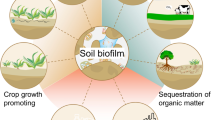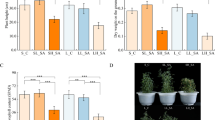Abstract
A metaproteomic approach, based on liquid chromatography-high resolution mass spectrometry (LC-HRMS) analysis, was followed to map the major bacterial metabolic functions associated with the rhizosphere of metal-tolerant and metal hyperaccumulator plants, growing in a serpentine soil naturally contaminated by heavy metals such as Ni, Co and Cr. In particular, an “in-house” bacterial protein database was built based on the genera recognised by 16S rDNA profiling, then it was used for protein identification from LC-MS data. The combination of the information arising from three different extraction protocols, applied to each soil sample, permitted the identification of almost 800 proteins, corresponding to functions assigned to proper Gene Ontology categories. Mainly proteins involved in response to stimulus or in transport of metals and nutrients revealed variability of bacteria responses to microenvironment conditions. As for taxonomy, Phyllobacterium, Microbacterium oxidans, Pseudomonas oryzihabitans, Stenotrophomonas rhizophila and Bacillus methylotrophicus bacterial species were more represented in the rhizosphere samples of the metal-tolerant Biscutella laevigata and of the Ni hyperaccumulator Noccaea caerulescens with respect to bulk soil. Combining 16S rRNA gene-based sequencing and metaproteomic analysis, we get insights into microbial community functions and their interaction with plants colonising the stressful environment of serpentine soils.





Similar content being viewed by others
References
Baker AJM, Ernst WHO, van der Ent A, Malaisse F, Ginocchio R. Metallophytes: the unique biological resource, its ecology and conservational status in Europe, central Africa and Latin America. In: Batty LC, Hallberg KB, editors. Ecology of industrial pollution. Cambridge: Cambridge University Press; 2010. p. 7–40.
Baker AJM, McGrath SP, Reeves RD, Smith JAC. Metal hyper accumulator plants: a review of the ecology and physiology of a biological resource for phytoremediation of metal-polluted soils. In: Terryand N, Bañuelos G, editors. Phytoremediation of contaminated soil and water. Boca Raton: CRC Press; 2000. p. 85–107.
Chaney RL, Angle JS, Broadhurst CL, Peters CA, Tappero RV, Sparks DL. Improved understanding of hyperaccumulation yields commercial phytoextraction and phytomining technologies. J Environ Qual. 2007;36:1429–43.
Krzciuk K, Gałuszka A. Prospecting for hyperaccumulators of trace elements: a review. Crit Rev Biotechnol. 2015;35:522–32.
Alford EM, Pilon-Smits EAH, Paschke MW. Metallophytes-a view from the rhizosphere. Plant Soil. 2010;337:33–50.
Ma Y, Prasad MNV, Rajkumar M, Freitas H. Plant growth promoting rhizobacteria and endophytes accelerate phytoremediation of metalliferous soils. Biotechnol Adv. 2011;29:248–58.
Visioli G, D’Egidio S, Vamerali T, Mattarozzi M, Sanangelantoni AM. Culturable endophytic bacteria enhance Ni translocation in the hyperaccumulator Noccaea caerulescens. Chemosphere. 2014;117:538–44.
Sessitsch A, Kuffner M, Kidd P, Vangronsveld J, Wenzel WW, Fallman K, et al. The role of plant-associated bacteria in the mobilization and phytoextraction of trace elements in contaminated soils. Soil Biol Biochem. 2013;60:182–94.
Visioli G, Vamerali T, Mattarozzi M, Dramis L, Sanangelantoni AM. Combined endophytes inoculants enhance nickel phytoextraction from serpentine soil in the hyperaccumulator Noccaea caerulescens. Front Plant Sci. 2015;6:Article 638.
Berg J, Brandt KK, Al-Soud WA, Holm PE, Hansen LH, Sørensen SJ, et al. Selection for Cu-tolerant bacterial communities with altered composition, but unaltered richness, via long-term Cu exposure. Appl Environ Microbiol. 2012;78:7438–46.
Gołębiewski M, Deja-Sikora E, Cichosz M, Tretyn A, Wróbel B. 16S rDNA pyrosequencing analysis of bacterial community in heavy metals polluted soils. Microb Ecol. 2014;67:635–47.
Hettich RL, Sharma R, Chourey K, Giannone RJ. Microbial metaproteomics: identifying the repertoire of proteins that microorganism use to compete and cooperate in complex environmental communities. Curr Opin Microbiol. 2012;15:373–80.
Wilmes P, Heintz-Buschart A, Bond PL. A decade of metaproteomics: where we stand and what the future holds. Proteomics. 2015;15:3409–17.
Arsène-Ploetze F, Bertin PN, Carapito C. Proteomic tools to decipher microbial community structure and functioning. Environ Sci Pollut Res. 2015;22:13599–612.
Bastida F, Moreno JL, Nicolás C, Hernández T, García C. Soil metaproteomics: a review of an emerging environmental science. Significance, methodology and perspectives. Eur J Soil Sci. 2009;60:845–59.
Hettich RL, Pan C, Chourey K, Giannone RJ. Metaproteomics: Harnessing the power of high performance mass spectrometry to identify the suite of proteins that cntrol metabolic activities in microbial communities. Anal Chem. 2013;85:4203–14.
Becher D, Bernhardt J, Fuchs S, Riedel K. Metaproteomics to unravel major microbial players in leaf litter and soil environments: challenges and perspectives. Proteomics. 2013;13:2895–909.
Giagnoni L, Magherini F, Landi L, Taghavi S, Modesti A, Bini L, et al. Extraction of microbial proteome from soil: potential and limitations assessed through a model study. Eur J Soil Sci. 2011;62:74–81.
Leary DH, Hervey WJ, Deschamps JR, Kusterbeck AW, Vora GJ. Reprint of “Which metaproteome? The impact of protein extraction bias on metaproteomic analyses”. Mol Cell Probes. 2014;28:51–7.
Keiblinger KM, Wilhartitz IC, Schneider T, Roschitzki B, Schmid E, Eberl L, et al. Soil metaproteomics - comparative evaluation of protein extraction protocols. Soil Biol Biochem. 2012;54:14–24.
Bastida F, Hernández T, García C. Metaproteomics of soils from semiarid environment: functional and phylogenetic information obtained with different protein extraction methods. J Proteomics. 2014;101:31–42.
Chourey K, Jansson J, VerBerkmoes N, Shah M, Chavarria KL, Tom LM, et al. Direct cellular lysis/protein extraction protocol for soil metaproteomics. J Proteome Res. 2010;9:6615–22.
Hansen SH, Stensballe A, Nielsen PH, Herbst F-A. Metaproteomics: evaluation of protein extraction from activated sludge. Proteomics. 2014;14:2535–9.
Benndorf D, Balcke GU, Harms H, von Bergen M. Functional metaproteome analysis of protein extracts from contaminated soil and groundwater. ISME J. 2007;1:224–34.
Bastida F, Jehmlich N, Lima K, Morris BEL, Richnow HH, Hernández T, et al. The ecological and physiological responses of the microbial community from a semiarid soil to hydrocarbon contamination and its bioremediation using compost amendment. J Proteomics. 2016;135:162–9.
Wu L, Wang H, Zhang Z, Lin R, Zhang Z, Lin W. Comparative metaproteomic analysis on consecutively Rehmannia glutinosa-monocultured rhizosphere soil. PLoS ONE. 2011;6:e20611.
Wang H-B, Zhang Z-X, Li H, He H-B, Fang C-X, Zhang A-J, et al. Characterization of metaproteomics in crop rhizospheric soil. J Proteome Res. 2011;10:932–40.
Knief C, Delmotte N, Chaffron S, Stark M, Innerebner G, Wassmann R, et al. Metaproteogenomic analysis of microbial communities in the phyllosphere and rhizosphere of rice. ISME J. 2012;6:1378–90.
Lin W, Wu L, Lin S, Zhang A, Zhou M, Lin R, et al. Metaproteomic analysis of ratoon sugarcane rhizospheric soil. BMC Microbiol. 2013;13:Article135.
Bao Z, Okubo T, Kubota K, Kasahara Y, Tsurumaru H, Anda M, et al. Metaproteomic identification of diazotrophic methanotrophs and their localization in root tissues of field-grown rice plants. Appl Environ Microbiol. 2014;80:5043–52.
Milani C, Hevia A, Foroni E, Duranti S, Turroni F, Lugli GA, et al. Assessing the fecal microbiota: an optimized ion torrent 16S rRNA gene-based analysis protocol. PLoS ONE. 2013;8:e68739.
Caporaso JG, Kuczynski J, Stombaugh J, Bittinger K, Bushman FD, Costello EK, et al. QIIME allows analysis of high-throughput community sequencing data. Nat Methods. 2010;7:335–6.
Edgar RC. Search and clustering orders of magnitude faster than BLAST. Bioinformatics. 2010;26:2460–1.
Quast C, Pruesse E, Yilmaz P, Gerken J, Schweer T, Yarza P, et al. The SILVA ribosomal RNA gene database project: improved data processing and web-based tools. Nucl Acids Res. 2013;41:D590-6. http://nar.oxfordjournals.org/content/41/D1/D590.
Lozupone C, Knight R. UniFrac: a new phylogenetic method for comparing microbial communities. Appl Environ Microbiol. 2005;71:8228–35.
Conesa A, Götz S, García-Gómez JM, Terol J, Talón M, Robles M. Blast2GO: a universal tool for annotation, visualization and analysis in functional genomics research. Bioinformatics. 2005;21:3674–6.
Kall L, Krogh A, Sonnhammer EL. A combined transmembrane topology and signal peptide prediction method. J Mol Biol. 2004;338:1027–36.
Freilich S, Kreimer A, Meilijson I, Gophna U, Sharan R, Ruppin E. The large-scale organization of the bacterial network of ecological co-occurrence interactions. Nucleic Acids Res. 2010;38:3857–68.
Naether A, Foesel BU, Naegele V, Wüst PK, Weinert J, Bonkowski M, et al. Environmental factors affect Acidobacterial communities below the subgroup level in grassland and forest soils. Appl Environ Microbiol. 2012;78:7398–406.
Visioli G, Vincenzi S, Marmiroli M, Marmiroli N. Correlation between phenotype and proteome in the Ni hyperaccumulator Noccaea caerulescens subsp. caerulescens. Environ Exp Bot. 2012;77:156–64.
Reinhold-Hurek B, Bünger W, Burbano CS, Sabale M, Hurek T. Roots shaping their microbiome: global hotspots for microbial activity. Annu Rev Phytopathol. 2015;53:403–24.
Ma Y, Rajkumar M, Freitas H. Isolation and characterization of Ni mobilizing PGPB from serpentine soils and their potential in promoting plant growth and Ni accumulation by Brassica spp. Chemosphere. 2009;75:719–25.
Idris R, Trifonova R, Puschenreiter M, Wenzel WW, Sessitsch A. Bacteria communities associated with flowering plants of the Ni hyperaccumulator Thlaspi goesingense. Appl Environ Microbiol. 2004;70:2667–77.
He H, Ye Z, Yang D, Yan J, Xiao L, Zhong T, et al. Characterization of endophytic Rahnella sp. JN6 from Polygonum pubescens and its potential in promoting growth and Cd, Pb, Zn uptake by Brassica napus. Chemosphere. 2013;90:1960–5.
Farinati S, DalCorso G, Panigati M, Furini A. Interaction between selected bacterial strains and Arabidopsis halleri modulates shoot proteome and cadmium and zinc accumulation. J Exp Bot. 2011;62:3433–47.
Barzanti R, Ozino F, Bazzicalupo M, Gabrielli R, Galardi F, Gonnelli C, et al. Isolation and characterization of endophytic bacteria from the nickel hyperaccumulator plant Alyssum bertolonii. Microb Ecol. 2007;53:306–16.
Abou-Shanab RA, Angle JS, Chaney RL. Bacterial inoculants affecting nickel uptake by Alyssum murale from low, moderate and high Ni soils. Soil Biol Biochem. 2006;38:2882–9.
Belimov AA, Safronova VI, Sergeyeva TA, Egorova TN, Matveyeva VA, Tsyganov VE, et al. Characterization of plant growth promoting rhizobacteria isolated from polluted soils and containing 1-aminocyclopropane-1-carboxylate deaminase. Can J Microbiol. 2001;47:642–52.
Long X-X, Chen X-M, Wong JW-C, Wei Z-B, Wu Q-T. Feasibility of enhanced phytoextraction of Zn contaminated soil with Zn mobilizing and plant growth promoting endophytic bacteria. Trans Nonferrous Metals Soc China. 2013;23:2389–96.
Rajkumar M, Ae N, Freitas H. Endophytic bacteria and their potential to enhance heavy metal phytoextraction. Chemosphere. 2009;77:153–60.
Dekkers LC, Bloemendal CJP, de Weger LA, Wijffelman CA, Spaink HP, Lugtenberg BJ. A two-component system plays an important role in the root-colonising ability of Pseudomonas fluorescens strain WCS365. Mol Plant Microbe Interact. 1998;11:45–56.
Nojnai N, Guillier M, Barnard TJ, Buchanan SK. TonB-dependent transporters: regulation, structure, and function. Annu Rev Microbiol. 2010;64:43–60.
Binkman KK, Larsen RA. Interactions of the energy transducer TonB with non-cognate energy-harvesting complexes. J Bacteriol. 2008;190:421–7.
Theriault G, Nkongolo KK. Evidence of prokaryote like protein associated with nickel resistance in higher plants: horizontal transfer of TonB-dependent receptor/protein in Betula genus or de novo mechanisms? Heredity 2016; 1–8.
Elferink MG, Albers SV, Konings WN, Driessen AJ. Sugar transport in Sulfolobus solfataricus is mediated by two families of binding protein-dependent ABC transporters. Mol Microbiol. 2001;39:1494–5.
Author information
Authors and Affiliations
Corresponding author
Ethics declarations
Funding
This research was in part supported by funding to Prof. Anna Maria Sanangelantoni and to Dr. Giovanna Visioli from FIL of the University of Parma Local Funding for Research.
Conflict of interest
The authors declare that they have no conflicts of interest.
Ethical approval
This article does not contain any studies with human or living animal subjects.
Informed consent
Not applicable
Electronic supplementary material
Below is the link to the electronic supplementary material.
ESM 1
(PDF 1970 kb)
Rights and permissions
About this article
Cite this article
Mattarozzi, M., Manfredi, M., Montanini, B. et al. A metaproteomic approach dissecting major bacterial functions in the rhizosphere of plants living in serpentine soil. Anal Bioanal Chem 409, 2327–2339 (2017). https://doi.org/10.1007/s00216-016-0175-8
Received:
Revised:
Accepted:
Published:
Issue Date:
DOI: https://doi.org/10.1007/s00216-016-0175-8




